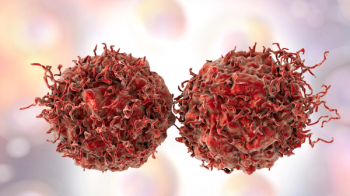
Preoperative radiation and pembrolizumab improved T-cell infiltration in patients with higher-risk, HR-positive, HER2-negative, early-stage breast cancer.
Russ Conroy is an Assistant Editor for CancerNetwork. He grew up in Hillsborough, New Jersey, and graduated from Rutgers University-New Brunswick in 2022.
On the weekends, he likes to unwind by playing video games with friends, tailgating at Rutgers football games with his family, or building his music collection with a visit to Princeton Record Exchange.

Preoperative radiation and pembrolizumab improved T-cell infiltration in patients with higher-risk, HR-positive, HER2-negative, early-stage breast cancer.

New AQUILA data show PFS improvement in patients with smoldering multiple myeloma who were treated with subcutaneous daratumumab vs active monitoring.

Findings from a small cohort of a phase 2b trial demonstrated 2-year OS benefit in patients with pulmonary metastatic osteosarcoma treated with OST-HER2.

The investigational BET inhibitor is being investigated combined with abemaciclib or cisplatin/etoposide in NUT carcinoma in 2 clinical trials.

A quality-adjusted time without symptoms or toxicity analysis identified better outcomes for patients with RCC treated with belzutifan vs everolimus.

Most patients demonstrated at least partial response to tarlatamab in a real-world population with extensive-stage small cell lung cancer.

Further data could back zanidatamab as advanced treatment for HER2-positive advanced gastroesophageal adenocarcinoma.

Volumetric PET biomarkers may help predict risk of toxicity from CAR T-cell therapy in patients with large B-cell lymphoma, new retrospective data suggest.

Biomarker data from CodeBreaK 300 suggest DNA and RTK pathway alterations may underlie resistance to sotorasib plus panitumumab in CRC.

The combination of trastuzumab deruxtecan with pertuzumab shows promise as a standard of care for HER2-positive advanced breast cancer.

COCOON skin care led to fewer or milder dermatologic symptoms with amivantamab/lazertinib vs standard care in patients with EGFR+ advanced NSCLC.

Adding immunotherapy to chemo may boost pCR and downstaging rates in the neoadjuvant setting for muscle-invasive bladder cancer.

KEYNOTE-B96 showed pembrolizumab-based therapy improved PFS and OS in PD-L1–positive platinum-resistant ovarian cancer.

The phase 2b SURVIVE trial of SurVaxM in newly diagnosed glioblastoma will continue as planned following an interim review by an independent safety board.

Black and Hispanic pediatric patients with high-risk neuroblastoma had significantly lower 5-year survival rates in induction and/or consolidation trials.

Early-phase LUPER trial results suggest the lurbinectedin/pembrolizumab combination may benefit patients with relapsed small cell lung cancer.

Final data from the phase 3 ALCYONE trial support frontline use of daratumumab-based therapy for patients with transplant-ineligible newly diagnosed multiple myeloma.

Using tools like the ICE Score could improve consistency in grading neurotoxicity tied to bispecific antibodies in hematologic cancers.

The complete response letter, issued by the FDA, does not identify what deficiencies regulators found in camrelizumab/rivoceranib for advanced HCC.

Updated MAIA trial results reinforce the frontline benefit of daratumumab plus lenalidomide/dexamethasone in transplant-ineligible NDMM.

A phase 2 trial found that pembrolizumab plus pemetrexed met its objective response rate primary end point.

The addition of trastuzumab and pertuzumab to chemotherapy was associated with increased toxicity in patients with HER2-positive gastric cancers enrolled in the INNOVATION trial.

Significant improvements in skin toxicity were observed by week 6 in all patients treated with HT-001 in the phase 2a CLEER-001 trial.

The addition of lenvatinib/pembrolizumab to TACE showed a numerical improvement in PFS, but longer follow-up is necessary to confirm this finding.

“This benefit in local recurrence translates into a later difference in distant recurrence and breast cancer [mortality], but it’s only apparent with long follow-up,” according to the study author.

Mirdametinib led to confirmed responses and meaningful pain and health-related quality of life improvements in both children and adults with neurofibromatosis type 1-associated PNs.


Adding E-602 to cemiplimab demonstrated anti-tumor effects in patients PD-L1–resistant solid cancers.

Mitazalimab combined with mFOLFIRINOX led to responses and survival benefits in patients with metastatic pancreatic ductal adenocarcinoma.

Surveyed individuals who identified as a racial or ethnic minority reported difficulties discussing cancer diagnosis and treatment.

Published: May 8th 2025 | Updated:

Published: July 10th 2025 | Updated:

Published: July 4th 2025 | Updated:

Published: June 4th 2025 | Updated:

Published: June 19th 2025 | Updated:

Published: February 28th 2023 | Updated: